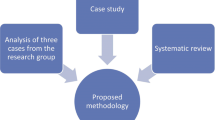Abstract
The overwhelming majority of the work involved in the development of external medical devices, as orthoses, consists in applying the companies’ empirical knowledge. However, this non structured method, in some cases, may lead to incomplete, inadequate or low products quality. This fact precludes the patient to use the device for long term and consequently the rehabilitation desired effect promoted by the orthosis is compromised. Based on that, to promote a superior product quality, different knowledge from several domains should be considered and should interact in order to achieve a common goal, during the development stages. Additionally, when the development concerns medical devices, the users’ needs and users’ interface and way to use it gain a major importance. The combination of these different factors is a difficult task and is usually overlooked by the companies. This fact demonstrates the importance of the implementation of a design approach for the development of medical devices, which will permit to plan and structure each stage of the products’ development. According to that, the goal of this study was to develop an innovative design approach for the development of an articulated external medical device (articular orthoses) based on the most significant moments during the device’s usage.





Similar content being viewed by others
References
Hoyos Ruiz, J., Martinez Cadavid, F., Osorio Gomez, G., Méjia Gutiérrez, R.: Implementation of ergonomic aspects throughout the engineering design process: human-artefact-context analysis. Int. J. Interact. Des. Manuf. 1, 1–15 (2015)
Kang, H., Long, J.P., Urbiel Golner, G.D., Goldstein, S.A., Hollister, S.J.: A paradigm for the development and evaluation of novel implant topologies for bone fixation: implant design and fabrication. J. Biomech. 45, 2241–2247 (2012)
Benabid, Y.: Contribution à l’amélioration du processus de conception des produits innovants : Développement d’outils d’aide au choix des processus. Génie des procédés. Ecole nationale supérieure d’arts et métiers–ENSAM, Français (NNT :2014ENAM0003) (2014)
Ammar, A.A.: Adaptation et mise en place d’un processus d’innovation et de conception au sein d’une PME. Automatique/Robotique. Arts et Métiers ParisTech, Français. (NNT : 2010ENAM0040) (2010)
Langeveld, L.: Product design with embodiment design as a new perspective. In: Coelho, D.A. (eds.) Industrial Design—New Frontiers. InTech, ISBN: 978-953-307-622-5 (2011)
Jin, Y., Plott, J., Chen, R., Wensman, J., Shih, A.: Additive manufacturing of custom orthoses and prostheses—a review. Procedia CIRP 36, 199–204 (2015)
Bitterman, N.: Design of medical devices—a home perspective. Eur. J. Intern. Med. 22(1), 39–42 (2011)
Jin, Y., He, Y., Shih, A.: Process planning for the fuse deposition modeling of ankle-foot-ohoses. Procedia CIRP 42(no. Isem Xviii), 760–765 (2016)
Lang, A.R., Martin, J.L., Sharples, S., Crowe, J.A.: The effect of design on the usability and real world effectiveness of medical devices: a case study with adolescent users. Appl. Ergon 44(5), 799–810 (2013)
Sharples, S., Martin, J., Lang, A., Craven, M., O’Neill, S., Barnett, J.: Medical device design in context: a model of user-device interaction and consequences. Displays 33(4–5), 221–232 (2012)
Henderson, W.H., Lamoreux, L.W.: The orthotic prescription derived from a concept of basic orthotic functions. Bull. Prosthet. Res. 10, 89–96 (1969)
Condie, D.N.: The modern era of orthotics. Prosthet. Orthot. Int. 32(3), 313–323 (2008)
ISO 8549-1. Prosthetics and orthotics—Vocabulary—Part 1: General terms for external limb prostheses and external orthoses. ISO 8549-1:1989 (2011)
Colombo, G., Filippi, S., Rizzi, C., Rotini, F., Milano, P.: A computer-assisted methodology to innovate the development process of prosthesis socket,. In: Fischer, X., Coutellier, D. (eds.) Research in Interactive design, pp 1–8. Springer, Paris (2006). ISBN: 2287483632
Council Directive 93/42/EEC of 14 June 1993 concerning medical devices. Off. J. Eur. Commun. 36, 44 (1993)
Fischer, X., Nadeau, J.-P.: Interactive design: then and now. Res. Interact. Des. 3, 1–5 (2011)
Fischer, X., Coutellier, D.: The interaction: a new way of designing. Res. Interact. Des. 3, 1–15 (2006)
McClelland, I., Suri, J.F.: Involving people in design. In: Wilson, J.R., Corlett, E.N. (eds.) Evaluation of human work, 3rd edn, pp. 281–333. Taylor and Francis, London (2004)
Maguire, M.: Methods to support human-centred design. Int. J. Hum. Comput. Stud. 55(4), 587–634 (2001)
Earthy, J., Jones, B.S., Bevan, N.: The improvement of human-centred processes–facing the challenge and reaping the benefit of ISO 13407. Int. J. Hum. Comput. Stud. 55(4), 553–585 (2001)
Martin, J.L., Norris, B.J., Murphy, E., Crowe, J.A.: Medical device development: the challenge for ergonomics. Appl. Ergon 39(3), 271–283 (2008)
ISO 13407. Human-centred Design Processes for Interactive Systems. International Organization for standardization, Geneva (1999)
Pahl, G., Beitz, W., Feldhusen, J., Grote, K.H.: Engineering Design—A Systematic Approach, 3rd edn. Springer, London. ISBN: 978-1-84628-319-2 (2007)
Ulrich, K.T., Eppinger, S.D.: Product Design and Development, 6th edn. p. 448. McGraw-Hill Education, ISBN: 978-0073404776 (2015)
Baxter, M.: Product Design, 2nd edn. p. 308. ISBN: 0748741976, 9780748741977 (1995)
Valverde, U., Nadeau, J.-P., Leon, J.F.: Innovation through pertinent patents research based on physical phenomena involved. Procedia CIRP 21, 515–520 (2014)
Hallbeck, M.S.: How to develop usable surgical devices—the view from a US research university. In: Duffy, V.G. (eds.) Advances in Human Factors and Ergonomics in Healthcare, pp. 286–295. CRC, Lincoln (2010)
Acknowledgments
The authors gratefully acknowledge the funding of ANRT and Lagarrigue Aquitaine SAS.
Author information
Authors and Affiliations
Corresponding author
Rights and permissions
About this article
Cite this article
Duarte, R., Mesnard, M. & Nadeau, JP. An innovative design approach to develop external articular medical devices. Int J Interact Des Manuf 11, 375–383 (2017). https://doi.org/10.1007/s12008-016-0341-4
Received:
Accepted:
Published:
Issue Date:
DOI: https://doi.org/10.1007/s12008-016-0341-4




